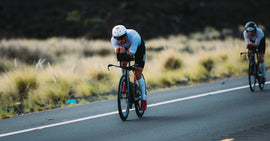Carbo-loading is one of the most common nutritional tools, often used by athletes to improve performance. It involves adjusting your diet and physical activity levels to increase the amount of carbohydrates stored in your body through food.
In today's post, we’ll talk about this "carbo-load," point out some common mistakes, and provide recommendations on how to do it correctly. Let’s dive in!
The Purpose of Carbo-Loading
The goal of carb-loading is essentially to supersaturate muscle and liver glycogen, the form of carbohydrate storage in muscles and the liver, respectively, a few days before the target event. The intent of maximizing muscle glycogen is to prepare your body for race day with energy reserves and ensure you don’t run out of energy before crossing the finish line. Ensuring maximum carbohydrate storage also gives your muscles the best chance of recovery. Did you know that?
Is carb-loading all it’s cracked up to be? Will it really make a difference in performance?
Like many other questions and answers in nutrition… it depends.
This strategy typically involves several days of eating more carbohydrates than usual while reducing training volume to decrease the amount of carbohydrates being used. The amount of carbohydrates you consume during loading days can vary from 5 to 12 grams per kilogram of body weight per day. If you’re lightly active but not competing or doing long training sessions, increasing carbohydrate stores is probably unnecessary for you. Also, if you eat more carbs when you don’t need them, you might end up altering your regular diet unnecessarily or consuming more calories than your body needs.
When Is Carbo-Loading Appropriate?
Carbo-loading is specifically appropriate for exercises that lead to significant reductions in muscle glycogen stores, like long cycling or endurance running. Research has shown that carb-loading can reduce fatigue and improve performance by 2-3% in exercises lasting over 90 minutes. However, it’s probably not effective for shorter periods of exercise or types of exercise involving short bursts of activity, like weightlifting.
In Summary:
Your body stores carbohydrates in the form of glycogen. Carb-loading is a strategy to increase glycogen stores and improve exercise performance. It may be effective in events lasting over 90 minutes, but it’s probably unnecessary for shorter workouts or events.
There are several specific carb-loading programs (6-day, 3-day, 1-day programs). The main differences between them are the duration and the amount of exercise they include. All of these programs use a short-term high-carbohydrate diet while temporarily reducing exercise.
The 1-day program is the simplest and follows this strategy: You don’t exercise for one day and consume a carbohydrate-rich diet of about 10g/kg of body weight.
Common Mistakes to Avoid Before Starting:
1) Eating Too Much Fat
Some people make the mistake of choosing foods that are both high in carbohydrates and fat, instead of just carbs. While fat can be part of a balanced diet, as you’re increasing carbohydrate intake, reducing fat intake can help prevent excessive calorie consumption. Overeating fatty foods can lead to weight gain or make you feel sluggish and "heavy." For example, many desserts like chocolate, ice cream, and cookies fall into this category, as well as creamy pasta sauces you might eat the night before.
2) Eating Too Much Fiber
Consuming too many fiber-rich foods can also be problematic. While fiber is an essential part of a healthy diet, too much fiber can cause stomach discomfort for some people. The carb-loading period is a unique time when it's better to opt for white bread (like fresh white rolls) instead of whole wheat bread. During this period, you should likely avoid high-fiber foods such as beans and salads.
3) Eating New or Unfamiliar Foods
The days leading up to your event or competition are crucial, and stomach discomfort due to unfamiliar foods can hurt both your experience and performance. That's why it’s best to choose foods that you're already familiar with—foods that are rich in carbohydrates, low in fat, and low in fiber. On race day, don’t try anything new, and that includes the foods you eat before the event!
4) Continuing to Train Too Much
Lastly, not reducing or "tapering" your training during the carb-loading phase can prevent glycogen stores from increasing, as they’re still being used up instead of stored.
Examples of Carbohydrate-Rich, Low-Fat, and Low-Fiber Foods:
-
Fruit juices
-
White pasta with tomato sauce
-
White bread
-
White rice
-
Peeled potatoes
-
Fruit compotes
-
Fruits, including bananas and oranges
-
White flour (used in cooking)
-
Fruit sorbet
-
Sports drinks
Of course, it’s also important to include protein in your meals to help repair and feed your muscles. Try to focus on lean protein sources such as fish, lean cuts of meat or poultry, and low-fat dairy products like white cheeses and light varieties.
Recap:
Carb-loading is a nutritional strategy to enhance exercise performance, involving two main components: increasing carbohydrate intake and reducing exercise levels. Carbohydrate intake can vary, but experts typically recommend a more restricted range of 8-10 grams per kilogram of body weight. This strategy may improve performance in exercises lasting more than 90 minutes, but it’s likely unnecessary for shorter-duration activities.
And don't forget to choose familiar foods that are high in carbs and low in fat. Also, be mindful of the amount of fiber you’re consuming during these days—after all, we don’t want any unpleasant surprises!
Thanks for reading, and see you in the next post!
References:
-
Jeukendrup AE. Nutrition for endurance sports: marathon, triathlon, and road cycling. J Sports Sci. 2011;29 Suppl 1:S91-9. doi: 10.1080/02640414.2011.610348. Epub 2011 Sep 15. PMID: 21916794.
-
Hawley JA, Schabort EJ, Noakes TD, Dennis SC. Carbohydrate-loading and exercise performance. An update. Sports Med. 1997 Aug;24(2):73-81. doi: 10.2165/00007256-199724020-00001. PMID: 9291549.
-
Sherman WM, Costill DL, Fink WJ, Miller JM. Effect of exercise-diet manipulation on muscle glycogen and its subsequent utilization during performance. Int J Sports Med. 1981 May;2(2):114-8. doi: 10.1055/s-2008-1034594. PMID: 7333741.


